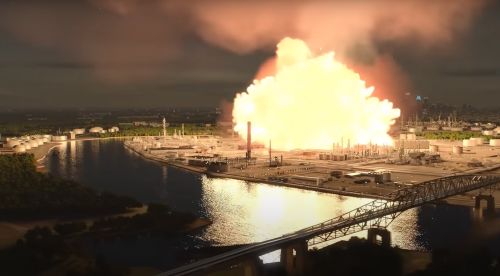

Alarms that didn’t sound. Valves that stuck. Temperature gauges nobody checked. Safety systems exist to prevent tragedy. When they work correctly, they catch problems before they become disasters. When they’re ignored or neglected, small failures cascade into catastrophic explosions.
The difference between a normal workday and a tragedy often comes down to whether someone maintained safety equipment, whether someone followed protocols, and whether management prioritized safety over production schedules. Understanding why explosions still happen reveals that most aren’t random accidents. They’re predictable consequences of negligence and corner-cutting.
How safety systems prevent tragedy until they’re ignored recognizes that explosions are largely preventable. Equipment fails. Alarms malfunction. Valves get stuck. These things happen. But proper maintenance, regular testing, and immediate response to issues prevent those failures from becoming disasters. When companies cut corners on maintenance, skip inspections, or pressure workers to keep production moving despite warning signs, explosions become likely rather than unlikely.
Learning why violations lead to refinery explosion safety failures reveals that most explosions result from human choices rather than mechanical impossibility, which means understanding refinery explosion safety violations shows that accountability is both possible and necessary.
Why Explosions Still Happen
Outdated equipment that hasn’t been upgraded in decades creates hazards. A pump designed for 1970s operating conditions doesn’t safely handle modern production pressures. Facilities built decades ago without modern safety systems operate on borrowed time. Equipment fails. Pressure builds. Something gives way. The system breaks. Explosions result.
Poor training leaves workers unprepared for emergencies. New hires trained quickly rather than thoroughly. Seasonal workers without adequate background. Emergency procedures that aren’t regularly practiced. When crisis hits, workers don’t know what to do. They follow wrong procedures or freeze. That confusion costs lives.
Skipped inspections mean problems accumulate undetected. An inspection that would catch a leaking valve gets deferred because production schedules don’t allow time. A routine maintenance check gets postponed. A safety test gets skipped. The problems that inspections would catch go unaddressed until catastrophic failure.
Common OSHA findings at facilities with histories of explosions show patterns of neglect. Maintenance records missing. Safety procedures not followed. Equipment beyond safe operating specifications. These aren’t surprises. These are documented failures that OSHA has cited repeatedly. Yet some facilities continue operating the same way.
Human error and production pressure create dangerous choices. Workers are told production targets must be met. Safety concerns are dismissed as obstacles. Workers feel pressure to keep things running even when conditions are unsafe. That pressure drives decisions that create danger.
The Cost of Neglect
Lives lost represent the human tragedy. Families lose breadwinners. Children lose parents. Communities lose neighbors. Blast victims suffer injuries that never fully heal. The human cost is immeasurable.
Property destroyed includes facilities worth hundreds of millions of dollars. Environmental contamination spreads to surrounding communities. Cleanup costs escalate into billions. Insurance doesn’t cover everything. Society absorbs costs.
Company reputation and legal penalties follow explosions. Criminal investigations happen. Civil lawsuits pile up. Regulatory fines accumulate. Some companies face criminal charges. Executives go to prison. That accountability, while important, comes after people are already dead or injured.
Emotional impact on workers and families extends far beyond immediate injuries. Survivors experience PTSD. Families grieve losses. Coworkers carry trauma. Mental health effects persist for years.
Recognizing Red Flags at Work
Frequent leaks signal that equipment isn’t being maintained properly. Leaks are warnings. If leaks are common, something is wrong. Management’s response to leaks determines whether problems get fixed or get ignored. Leaks that persist indicate negligence.
Unreported near-misses mean workers are either not reporting problems or management is ignoring reports. Near-misses are learning opportunities. When they’re ignored, the underlying problems persist. Eventually, a near-miss becomes a disaster.
Broken alarms that aren’t repaired immediately represent immediate danger. Alarms exist for a reason. A broken alarm leaves workers without warning. Management’s willingness to operate without functioning alarms demonstrates their safety priorities.
Worker right to report unsafe conditions is protected by law. OSHA gives workers the right to refuse unsafe work. Whistleblower protections prevent retaliation. Using these protections matters. Workers who speak up can change conditions and prevent disasters.
After an Explosion
Medical and legal steps must happen immediately. Get evaluated. Document injuries. Report to authorities. Preserve evidence. Act quickly.
Importance of independent investigation means hiring your own experts in addition to company or government investigators. Your experts work for you. They document problems from your perspective. Their findings support your case.
How victims build cases from safety-violation evidence means gathering documentation of prior complaints, maintenance failures, and ignored warnings. OSHA inspection reports. Maintenance logs. Worker complaints. All create evidence that negligence caused the explosion.
Conclusion
Summarizing warning signs and prevention means understanding that workers can identify dangerous conditions. When you see red flags, they matter. Speaking up protects everyone.
Encouraging workers to speak up recognizes that workers have the power to prevent disasters. When enough workers refuse unsafe conditions and report problems, companies respond. That collective action saves lives.
Understanding accountability for refinery explosion safety violations means recognizing that management decisions cause explosions. Those decisions can be proven negligent. That proof can result in accountability and justice.


